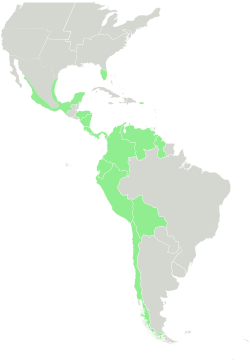Annona cherimola
Annona cherimola Mill.
| Order | Magnoliales |
|---|---|
| Family | Annonaceae |
| Genus | Annona |
2n = 14, 16
Origin : highland Andes
wild and cultivated
| English | cherimoya |
|---|---|
| French | chérimolier / chérimole |
- fruit eaten raw, in sherbet or in juice
Description
-
tree
-
leaves
-
fresh seeds (righ), left some hours at air (left)
-
range (wild)
-
range (wild and naturalised)
Popular names
| English | cherimoya |
| French | chérimolier, chérimoyer, chirimoya, annone, corossol du Pérou |
| German | Cherimolia, Cherimoyabaum, Peruanischer Fraschenbaum (Fouqué) ; Cherimoya |
| Italian | chirimoyo / anona, annona, chirimoya |
| Spanish | anón (Gua), chirimoya (Es, Aml), chirimoya del Peru (Es), chirimorrinón (Vén) (Fouqué) ; chirimoyo / chirimoya |
| Portuguese | anona do Chile (Bré), chirimolia (Fouqué) ; cherimóia |
| Kannada | hanumaanaphala (Wealth of India) |
| Telugu | hanumaanaphalamuchettu / lakshmanaphalamu (Wealth of India) |
| Thailand | noina ostrelia (PROSEA) |
- See the French names of the Flore populaire of Eugène Rolland
- See the etymology of cherimola and Annona.
Classification
Annona cherimola Mill. (1768)
synonym:
- A. cherimolia auct.
Cultivars
History
Uses
CHERIMALLA. CHERIMOYA. CHERIMOYER. CUSTARD APPLE. American tropics. Originally from Peru, this species seems to be naturalized only in the mountains of Port Royal in Jamaica. Venezuela, New Granada and Brazil know it only as a plant of cultivation. It has been carried to the Cape Verde Islands and to Guinea [1]. The cherimoya is not mentioned among the fruits of Florida by Atwood in 1867 but is included in the American Pomological Society's list for 1879 [2]. In 1870, specimens were growing at the United States Conservatory in Washington. The fruit is esteemed by the Peruvians as not inferior to any fruit of the world. Humboldt speaks of it in terms of praise. Herndon [3] says Huanuco is par excellence the country of the celebrated cherimoya, and that he has seen it there quite twice as large as it is generally seen in Lima and of the most delicious flavor. Masters says [4], however, that Europeans do not confirm the claims of the cherimoya to superiority among fruits, and the verdict is probably justified by the scant mention by travellers and the limited diffusion.
Dans les meilleures variétés, la pulpe du fruit est parfumée et à la fois sucrée et légèrement acide. Elle est consommée crue ou sert à la confection de boissons et sorbets. La fragilité du fruit empêche son transport loin des zones de production.
Cultivated in highlands between 1.000 and 2.500 m asl; already in pre-Colombian times introduced in Mexico, Central America, Brazil and Chile. Nowadays grown in South and Central America, India, Sri Lanka and the Philippines, also in subtropical regions of Mexico, California, Florida, South Africa, New Zealand and Australia, furthermore in isl. as Hawaii, Madeira, Canary Isl., the Antilles and under special treatment also in the Mediterranean region, e.g. S Spain, S Italy, Israel, Egypt, Libya, Somalia, Algeria. The fruit is said to be one of the finest of tropical fruits. The custard-like flesh is eaten raw, it has a blend of sweetness and mild acidity combined with flavours of pineapple, pear and its own, also used in milk-shakes or in cream and preserves. A hybrid between A. cherimola and A. squamosa, called Atemoya, is cultivated in S Florida, India, Philippines, N Australia. It is also used as a dessert fruit. Wild distribution: Interandean valleys of Peru, Bolivia and Ecuador.
References
- Alekseev, V. P. (1967) - Čerimojja. Annona cherimolia Mill., sem. Annonovych (Annonaceae). - Subtrop. Kul'tury (1): 116-121.
- Chauvet, Michel, 2018. Encyclopédie des plantes alimentaires. Paris, Belin. 880 p. (p. 62)
- Constantino, F. (1962) - L'Anona cherimolia. - Agricoltura 11 (12) Rome: 37-40.
- Fouqué, 1972, Espèces fruitières d'Amérique tropicale. Paris, IFAC
- Gade, D. W. (1975) - Plants, man and the land in the Vilcanota Valley of Peru. - Biogeographica 6 Junk Publ. The Hague: 240 pp.
- Garcia Pittmann, E. (1956) - La chirimoya (Annona cherimola Mill.). - Estac. Expt. Agr. de la Molina 71 Lima: 1-26.
- León, J. (1987) - Botanica de los cultivos tropicales. 2. ed. rev. y aumentada. - Coleccion libros y materiales educativos 84 Inst. Interamericano de Crop. para la Agricult. San Jose: 445 pp.
- Morton, J. F. (ed.) - Fruits of warm climates. Creative Resource System Winterville, N.C. 1987: 505 pp.
- Sauer, C. O. (1950): Cultivated plants of South and Central America (pp 487-543) - In: J. H. Steward (ed.) - Handbook of South American Indians 6 Bull. Bureau Amer. Ethnol., Smithsonian Inst. 143,6 Washington: 715 pp.
- Sánchez-Monge, E. - Flora Agricola, tomo I. Ministerio de Agricultura, Pesca y Alimentacion 1991: 1294 pp.
- Velázquez Diez, J. (1953) - El chiromoyo en la costa granadina. - Agricultura 22 Madrid: 432-434.





